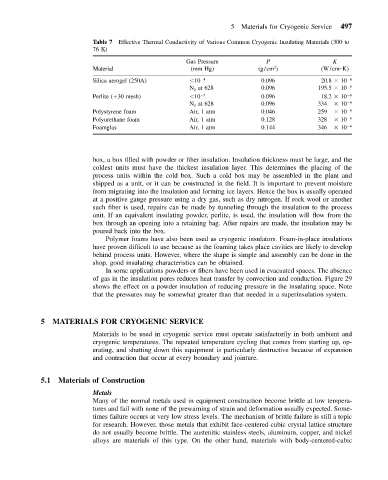Page 508 - Mechanical Engineers' Handbook (Volume 4)
P. 508
5 Materials for Cryogenic Service 497
Table 7 Effective Thermal Conductivity of Various Common Cryogenic Insulating Materials (300 to
76 K)
Gas Pressure P K
Material (mm Hg) (g/cm ) (W/cm K)
2
Silica aerogel (250A) 10 4 0.096 20.8 10 6
N 2 at 628 0.096 195.5 10 6
Perlite ( 30 mesh) 10 5 0.096 18.2 10 6
N 2 at 628 0.096 334 10 6
Polystyrene foam Air, 1 atm 0.046 259 10 6
Polyurethane foam Air, 1 atm 0.128 328 10 6
Foamglas Air, 1 atm 0.144 346 10 6
box, a box filled with powder or fiber insulation. Insulation thickness must be large, and the
coldest units must have the thickest insulation layer. This determines the placing of the
process units within the cold box. Such a cold box may be assembled in the plant and
shipped as a unit, or it can be constructed in the field. It is important to prevent moisture
from migrating into the insulation and forming ice layers. Hence the box is usually operated
at a positive gauge pressure using a dry gas, such as dry nitrogen. If rock wool or another
such fiber is used, repairs can be made by tunneling through the insulation to the process
unit. If an equivalent insulating powder, perlite, is used, the insulation will flow from the
box through an opening into a retaining bag. After repairs are made, the insulation may be
poured back into the box.
Polymer foams have also been used as cryogenic insulators. Foam-in-place insulations
have proven difficult to use because as the foaming takes place cavities are likely to develop
behind process units. However, where the shape is simple and assembly can be done in the
shop, good insulating characteristics can be obtained.
In some applications powders or fibers have been used in evacuated spaces. The absence
of gas in the insulation pores reduces heat transfer by convection and conduction. Figure 29
shows the effect on a powder insulation of reducing pressure in the insulating space. Note
that the pressures may be somewhat greater than that needed in a superinsulation system.
5 MATERIALS FOR CRYOGENIC SERVICE
Materials to be used in cryogenic service must operate satisfactorily in both ambient and
cryogenic temperatures. The repeated temperature cycling that comes from starting up, op-
erating, and shutting down this equipment is particularly destructive because of expansion
and contraction that occur at every boundary and jointure.
5.1 Materials of Construction
Metals
Many of the normal metals used in equipment construction become brittle at low tempera-
tures and fail with none of the prewarning of strain and deformation usually expected. Some-
times failure occurs at very low stress levels. The mechanism of brittle failure is still a topic
for research. However, those metals that exhibit face-centered-cubic crystal lattice structure
do not usually become brittle. The austenitic stainless steels, aluminum, copper, and nickel
alloys are materials of this type. On the other hand, materials with body-centered-cubic

